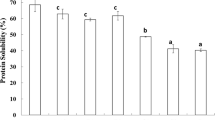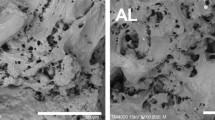Abstract
Effects of microbial transglutaminase (MTGase), fibrin/thrombin combination (fibrimex), alginate or combination of these binding agents on physicochemical parameters of cooked ground beef with reduced salt level were investigated. Seventeen treatments included three control (no binding agent) groups incorporated with varying concentrations of salt (0.5, 1, 2%, w/w) and fourteen treatment groups produced with MTGase or fibrimex or alginate or their combinations at 0.5 or 1% salt levels. The samples were analyzed for cooking loss (CL), pH, color, moisture, fat, protein, ash, salt, texture and TBARS. The results indicated that the use of MTGase or fibrimex or MTGase/fibrimex combination had significant effect on preventing textural deterioration caused by salt reduction. Even though the use of MTGase resulted in higher CL values, formulation of ground beef with fibrimex or alginate or MTGase/fibrimex/alginate combinations reduced CL when compared with the control groups. The use of fibrimex in ground beef resulted in a decrease in TBARS, lightness, redness and pH values. However, the use of alginate caused an increase in pH, lightness and redness values of ground beef. Based on the present study, the use of fibrimex or a combination of fibrimex with MTGase in the product formulation can be an effective strategy to reduce cooking loss, to improve or maintain the textural properties and to extend shelf life of cooked ground beef with reduced salt level.


Similar content being viewed by others
References
Ahhmed AM, Kawahara S, Ohta K, Nakade K, Soeda T, Muguruma M (2007) Differentiation in improvements of gel strength in chicken and beef sausages induced by transglutaminase. Meat Sci 76:455–462
Aktaş N, Kılıç B (2005) Effect of microbial transglutaminase on thermal and electrophoretic properties of ground beef. LWT Food Sci Technol 38:815–819
Anonymous (2002) Basic properties of transglutaminase. Ajinomoto Co. Manual. Ajinomoto Co., Tokyo
AOAC (1995) Official methods of analysis of AOAC international, vol I and II, 16th edn. Association of Analytical Communities, Arlington
Askin OO, Kilic B (2009) Effect of microbial transglutaminase, sodium caseinate and non-fat dry milk on quality of salt-free, low fat turkey döner kebab. LWT Food Sci Technol 42(10):1590–1596
Bhaskar Reddy GV, Mandal PK, Sen AR, Reddy KS (2015) Developments in science, technology, quality and constraints of restructured meat products—a review. Int J Meat Sci 5(1):14–48
Boles JA, Shand PJ (1999) Effects of raw binder system, meat cut and prior freezing on restructured beef. Meat Sci 53:233–239
Clarke AD, Sofos JN, Schmidt GR (1988) Effect of algin/calcium binder levels on the various characteristics of structured beef. J Food Sci 53(711–713):726
Colmenero FJ, Ayo MJ, Carballo J (2005) Physicochemical properties of low sodium frankfurter with added walnut: effect of transglutaminase combined with caseinate, KCl and dietary fibre as salt replacers. Meat Sci 69(4):781–788
da Fonseca MC, Salay E (2008) Beef, chicken and pork consumption and consumer safety and nutritional concerns in the City of Campinas, Brazil. Food Control 19(11):1051–1058
Desmond E (2006) Reducing salt: a challenge for the meat industry. Meat Sci 74(1):188–196
Dimitrakopoulou MA, Ambrosiadisb JA, Zetoub FK, Bloukasa JG (2005) Effect of salt and transglutaminase (TG) level and processing conditions on quality characteristics of phosphate-free, cooked, restructured pork shoulder. Meat Sci 70(4):743–749
Flores NC, Boyle EA, Kastner CL (2007) Instrumental and consumer evaluation of pork restructured with activatm or fibrimextm formulated with and without phosphate. LWT Food Sci Technol 40:179–185
Handley D, Ma-Edmonds M, Hamouz F, Cuppett S, Mandigo R, Schnepf M (1996) Controlling oxidation and warmed-over flavour in precooked pork chops with rosemary oleoresin and edible film. In: Shahidi F (ed) Natural antioxidants chemistry, health effect and application. AOCS Press, Champaign, pp 311–318
Hong GP, Chin KB (2009) Optimisations of calcium alginate and microbial transglutaminase systems to form a cold-set myofibrillar protein gelation. Korean J Food Sci Anim Resour 5:590–598
Jimenez-Colmenero F, Cofrades S, Lopez-Lopez I, Ruiz-Capillas C, Pintado T, Solas M (2010) Technological and sensory characteristics of reduced/low-fat, low salt frankfurters as affected by the addition of konjac and seaweed. Meat Sci 84:356–363
Kieliszek M, Misiewicz A (2014) Microbial transglutaminase and its application in the food industry. A review. Folia Microbiol 59:241–250
Kilic B (2003) Effect of microbial transglutaminase and sodium caseinate on quality of chicken döner kebab. Meat Sci 63:417–421
Kılıç B, Şimşek A, Claus JR, Atılgan E (2014) Encapsulated phosphates reduce lipid oxidation in both ground chicken and ground beef during raw and cooked meat storage with some influence on color, pH, and cooking loss. Meat Sci 97(1):93–103
Kumazawa Y, Seguro K, Takamura M, Motoki M (1993) Formation of є-(γ-glutamyl) lysine cross-link in cured horse mackerel meat induced by drying. J Food Sci 58:1062–1067
Laemmli UK (1970) Cleavage of structural proteins during the assembly of the head bacteriophage T4. Nature 227:680–685
Lee KY, Mooney DJ (2012) Alginate: properties and biomedical applications. Prog Polym Sci 37(1):106–126
Lee HG, Lanier TC, Hamann DD, Knopp JA (1997) Transglutaminase effects on low temperature gelation of fish protein sols. J Food Sci 62(1):20–24
Lemon DW (1975) An improved TBA test for rancidity. New Series Circular No. 51. Halifax Laboratory, Halifax
Lennon AM, Mcdonald K, Moon SS, Ward P, Kenny TA (2010) Performance of cold-set binding agents in re-formed beef steaks. Meat Sci 85(4):620–624
Moreno HM, Borderías AJ, Baron C (2010) Evaluation of some physico-chemical properties of restructured trout and hake mince during cold gelation and chilled storage. Food Chem 120:410–417
Nishimoto S, Hashimoto A, Seki N, Kimura I, Toyoda K, Arai K (1987) Influencing factors on changes in myosin heavy chain jelly strength of salted meat paste from Alaska pollack during setting. Nippon Suisan Gakk 56:1341
Pietrasik Z, Li-chan ECY (2002) Response surface methodology study of the effect of salt, microbial transglutaminase and heating temperature on pork batter gel properties. Food Res Int 35(4):387–396
Pietrasik Z, Jarmoluk A, Shand PJ (2007) Effect of non-meat proteins on hydration and textural properties of pork meat gels enhanced with microbial transglutaminase. LWT Food Sci Technol 40:915–920
Ruusunen M, Tirkkonen MS, Puolanne E (2001) Saltiness of coarsely ground cooked ham with reduced salt content. Agric Food Sci Finl 10:27–32
Tseng TF, Liu DC, Chen MT (2000) Evaluation of transglutaminase on the quality low-salt chicken meat balls. Meat Sci 55:427–431
Tseng TF, Tsai CM, Yang JH, Chen MT (2006) Porcine blood plasma transgluataminase combined with thrombin and fibrinogen as a binder in restructured meat. Asian Austral J Anim 19(7):1054–1058
Uran H, Aksu F, Yilmaz İ, Durak MZ (2013) Effect of transglutaminaseon the quality properties of chicken breast patties. Kafkas Univ Vet Fak Derg 19:331–335
Verma AK, Banerjee R (2012) Low-sodium meat products: retaining salty taste for sweet health. Crit Rev Food Sci Nutr 52(1):72–84
Wu Y, Weller CL, Hamouz F, Cuppett S, Schnepf M (2001) Moisture loss and lipid oxidation for precooked ground-beef patties packaged in edible starch-alginate-based composite films. J Food Sci 66:486–493
Yokoyama K, Nio N, Kikuchi Y (2004) Properties and applications of microbial transglutaminase. Appl Microbiol Biotechnol 64:447–454
Acknowledgements
Appreciation is expressed to Suleyman Demirel University Scientific Research Projects Support Office for providing financial support for this work (Project No. 3480-YL2-13).
Author information
Authors and Affiliations
Corresponding author
Rights and permissions
About this article
Cite this article
Atilgan, E., Kilic, B. Effects of microbial transglutaminase, fibrimex and alginate on physicochemical properties of cooked ground meat with reduced salt level. J Food Sci Technol 54, 303–312 (2017). https://doi.org/10.1007/s13197-016-2463-x
Revised:
Accepted:
Published:
Issue Date:
DOI: https://doi.org/10.1007/s13197-016-2463-x




